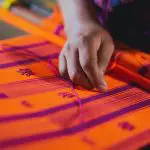Are you curious about the next big trend in fabrics? Rotary screen printing may just be the game changer you've been looking for.
This innovative technique has been gaining attention for its ability to produce high-quality, intricate designs on various types of fabrics.
With its precise and efficient process, rotary screen printing offers a range of advantages that are reshaping the textile industry. From enhancing the intricacy of designs to improving color vibrancy, this printing method is making a significant impact on textile design.
In this introduction, we'll explore the potential of rotary screen printing and its role in shaping the future of fabric production.
Key Takeaways
- Rotary screen printing offers advantages such as continuous patterns, faster production rates, and versatility for various fabric types and styles.
- The technology empowers designers to push boundaries of creativity, streamline production processes, and meet the growing demand for custom and bespoke designs.
- Rotary screen printing aligns with eco-friendly practices, allowing for the use of water-based inks, minimal ink and material waste, and energy efficiency.
- The future outlook for rotary screen printing includes advancements in digital integration, eco-friendly solutions, enhanced precision, and continued investment in research and development to meet market demand.
History of Rotary Screen Printing
In the history of rotary screen printing, you'll find that the technique was first developed in the late 20th century as a more efficient and versatile alternative to traditional flatbed printing methods. This marked a significant evolution in textile printing technology, as rotary screen printing allowed for continuous patterns to be produced at a much faster rate than the traditional methods. The innovation of rotary screen printing also brought about advancements in the types of dyes and inks that could be used, leading to a broader range of applications across various fabrics.
The technology behind rotary screen printing enabled finer details and intricate designs to be accurately reproduced, making it highly sought after in the fashion and home furnishing industries. The evolution of rotary screen printing has also seen the incorporation of digital technologies, further enhancing its capabilities and applications. This seamless integration of technology has allowed for greater precision and customization in the printing process, catering to the diverse needs of designers and manufacturers.
As a result, rotary screen printing continues to be at the forefront of fabric printing, offering unparalleled quality and versatility in the production of textiles.
Advantages of Rotary Screen Printing
You'll appreciate the efficiency and versatility of rotary screen printing due to its ability to produce high-quality continuous patterns at a rapid pace. This printing method offers several advantages that make it a popular choice in the textile industry:
- Cost Efficiency: Rotary screen printing is cost-effective for large production runs. It allows for high-speed production with minimal setup time, making it an economical choice for bulk fabric printing.
- Intricate Designs: The technology of rotary screen printing enables the creation of highly detailed and intricate designs. This method can achieve fine lines, intricate patterns, and vibrant colors with precision, making it suitable for a wide range of fabric types and styles.
- Versatility: Whether it's for clothing, upholstery, or other textile applications, rotary screen printing can accommodate various fabrics, including cotton, silk, polyester, and more. Its flexibility in handling different types of materials makes it a versatile option for fabric printing needs.
These advantages highlight the appeal of rotary screen printing for manufacturers and designers seeking efficient, cost-effective, and high-quality fabric printing solutions.
Impact on Textile Design Industry
With its ability to revolutionize fabric design processes and elevate creative possibilities, rotary screen printing has significantly impacted the textile design industry. This innovative printing technique has opened up new avenues for textile innovation, allowing designers to explore intricate patterns, vibrant colors, and unique textures that were previously difficult to achieve. The impact of rotary screen printing on the textile design industry can be seen in various aspects, such as enhanced creativity, streamlined production, and increased demand for bespoke designs.
| Impact on Textile Design Industry | Description |
|---|---|
| Enhanced Creativity | Rotary screen printing has empowered designers to push the boundaries of textile design, leading to the creation of visually stunning and intricate patterns. |
| Streamlined Production | The efficiency of rotary screen printing has enabled textile designers to streamline their production processes, resulting in faster turnaround times and increased productivity. |
| Increased Demand for Bespoke Designs | The creative possibilities offered by rotary screen printing have sparked a growing demand for custom and bespoke textile designs, catering to the preferences of discerning customers seeking unique and personalized fabrics. |
The impact of rotary screen printing on the textile design industry is undeniable, shaping the way designers approach creativity and production processes while meeting the growing demand for unique and innovative textile designs.
Sustainability and Rotary Screen Printing
When considering sustainability and rotary screen printing, it's important to examine how this printing method aligns with eco-friendly practices and resource conservation. Rotary screen printing offers several advantages in terms of sustainability and environmental impact:
- Water-Based Inks: Rotary screen printing allows for the use of water-based inks, which have a lower environmental impact compared to solvent-based inks. These inks are free from harmful chemicals and reduce air pollution during the printing process.
- Reduced Waste: The precision of rotary screen printing results in minimal ink wastage and fewer production errors, leading to reduced material waste. This contributes to a more sustainable and efficient printing process.
- Energy Efficiency: The use of advanced technologies in rotary screen printing contributes to energy efficiency, lowering overall energy consumption and reducing the carbon footprint of the printing process.
These aspects demonstrate that rotary screen printing can align with sustainable practices by minimizing environmental impact, conserving resources, and promoting eco-friendly ink usage.
As the industry continues to prioritize sustainability, rotary screen printing presents itself as a promising option for environmentally conscious fabric production.
Future Outlook for Rotary Screen Printing
Look forward to advancements in technology that will revolutionize rotary screen printing. As emerging technology continues to shape the textile industry, rotary screen printing is poised to experience significant improvements in efficiency and versatility. Manufacturers are investing in research and development to meet the growing market demand for high-quality, customizable fabrics.
| Advancements in Rotary Screen Printing | ||
|---|---|---|
| 1. Digital Integration | 2. Eco-friendly Solutions | 3. Enhanced Precision |
| Digital integration allows for seamless design transfer, leading to faster setup times and reduced material waste. | Eco-friendly solutions, such as water-based inks and sustainable substrates, are being developed to meet the increasing demand for environmentally conscious practices. | Enhanced precision in rotary screen printing is being achieved through cutting-edge engineering and software, resulting in intricate designs with unparalleled detail. |
| 4. Automation and Robotics | 5. Customization Capabilities | |
| Automation and robotics are being integrated into the printing process, optimizing production efficiency and minimizing human error. | Customization capabilities are expanding, allowing for on-demand printing of unique designs, patterns, and color variations. |
These advancements signify an exciting future for rotary screen printing, as it continues to meet the evolving needs of the textile industry.
Frequently Asked Questions
What Are the Main Challenges Faced by Manufacturers When Implementing Rotary Screen Printing Technology?
When implementing rotary screen printing technology, challenges arise in calibration, maintenance, and initial setup. Innovation in this area requires careful consideration of these challenges to ensure successful implementation and continued efficiency in the manufacturing process.
How Does Rotary Screen Printing Compare to Other Printing Methods in Terms of Cost and Efficiency?
When comparing rotary screen printing to other methods, consider the cost comparison and efficiency analysis. Rotary screen printing may offer cost savings and enhanced efficiency, making it an appealing choice for fabric manufacturers.
Are There Any Limitations to the Types of Fabrics That Can Be Printed Using Rotary Screen Printing?
When considering rotary screen printing, it's essential to understand the limitations in fabric compatibility. Different fabrics may affect ink adhesion and the complexity of designs. It's important to assess these factors before proceeding with this method.
What Are the Key Considerations for Manufacturers Looking to Adopt Sustainable Practices in Rotary Screen Printing?
When considering sustainable practices in rotary screen printing, manufacturers should prioritize eco-friendly inks, energy-efficient processes, and effective waste management. These key considerations contribute to reducing environmental impact and aligning with sustainable objectives.
How Is Digital Technology Influencing the Future of Rotary Screen Printing in the Textile Industry?
Digital innovation is transforming rotary screen printing in the textile industry. Advanced technology enables intricate designs and faster production. Companies are integrating sustainability initiatives, reducing water and energy use. Embracing these changes can position you at the forefront of industry trends.
- Can You Get Organza Wet? - April 23, 2024
- Why Is Organza so Popular? - April 23, 2024
- What Do You Wear With Organza? - April 23, 2024







